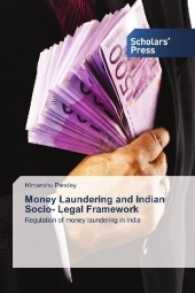Full Description
The subcommissural organ is a secretory ependymo-glial structure of the brain. It secretes glycoproteins into the cerebrospinal fluid. The chemical nature of this material is only partly known, and the functional role of the entire circumventricular complex has remained enigmatic. New experimental models include transplantation, immunological blockade, and experimental and clinical hydrocephalus. This book in the field contains provocative ideas and will most likely stimulate further investigations into molecular and systemic aspects of the problem.
Contents
I. Historical Reflections.- Ernst Reissner (1824-1878): Anatomist of the "Membrane" and "Fiber" (With 1 Figure).- Helmut Hofer (1912-1989) and the Concept of the Circumventricular Organs (With 1 Figure).- Historical Landmarks in the Investigation of the Subcommissural Organ and Reissner's Fiber (With 1 Figure).- II. Phylogeny and Ontogeny.- Phylogenetic and Conceptual Aspects of the Subcommissural Organ (With 3 Figures).- Reissner's Fiber Mechanisms: Some Common Denominators (With 3 Figures).- Ontogenetic Development of the Subcommissural Organ with Reference to the Flexural Organ (With 2 Figures).- Developmental Aspects of the Subcommissural Organ: An Approach Using Lectins and Monoclonal Antibodies (With 5 Figures).- The Subcommissural Organ and Ontogenetic Development of the Brain (With 5 Figures).- III. Biochemistry.- Protein Glycosylation in Mammalian Cells (With 3 Figures).- Partial Characterization of the Secretory Products of the Subcommissural Organ (With 3 Figures and 1 Table).- Biochemical and Immunochemical Analysis of Specific Compounds in the Subcommissural Organ of the Bovine and Chick (With 4 Figures and 3 Tables).- Immunochemical Analysis of the Dogfish Subcommissural Organ (With 2 Figures and 1 Table).- IV. Secretory Process, Including Model Systems.- Dynamic Aspects of the Secretory Process in the Amphibian Subcommissural Organ.- Evidence for the Release of CSF-Soluble Secretory Material from the Subcommissural Organ, with Particular Reference to the Situation in the Human (With 3 Figures).- The Subcommissural Organ In Vitro (With 2 Figures).- V. Relation to Other Circumventricular Organs: Conceptual Aspects.- Circumventricular Organs and Modulation in the Midsagittal Plane of the Brain (With 1 Figure and 1 Table).- Blood- and Cerebrospinal Fluid-Dominated Compartments of the Rat Brain (With 1 Figure).- VI. Neural Inputs.- The Subcommissural Organ of the Rat: An In Vivo Model of Neuron-Glia Interactions (With 2 Figures and 1 Table).- Neural Inputs to the Subcommissural Organ (With 2 Figures).- Impairment of the Serotoninergic Innervation of the Rat Subcommissural Organ after Early Postnatal X-Irradiation of the Brain Stem (With 2 Figures).- Immunocytochemistry of Neuropeptides and Neuropeptide Receptors in the Subcommissural Organ of the Rat (With 10 Figures).- VII. Connections with Other Brain Structures.- Relationships Between the Subcommissural Organ and the Pineal Complex (With 2 Figures).- The Goldfish Subcommissural Organ Is Not Innervated by Fibers of the Pineal Tract (With 2 Figures).- Immunochemical Relationships Between the Subcommissural Organ and Hypothalamic Neurons (With 6 Figures and 1 Table).- VIII. Physiology of the Cerebrospinal Fluid.- Cerebrospinal Fluid Secretion: The Transport of Fluid and Electrolytes by the Choroid Plexus (With 4 Figures).- Physiology of Cerebrospinal Fluid Circulation: Amphibians, Mammals, and Hydrocephalus (With 6 Figures and 1 Table).- IX. Experimental Aspects.- Effects of Hibernation and Hypothermia on the Secretory Activity of the Subcommissural Organ (With 3 Figures).- The Subcommissural Organ: Immunohistochemistry and Potential Relations to Salt/Water Balance (With 6 Figures and 1 Table).- Immunological Blockade of the Subcommissural Organ - Reissner's Fiber Complex (With 6 Figures).- The Effect of Immunological Blockade of Reissner's Fiber Formation on the Circulation of Cerebrospinal Fluid Along the Central Canal of the Rat Spinal Cord (With 4 Figures).- X. Discussion Sessions (With 3 Figures).- I Signal Pathways.- II Cell Biology and Biochemistry.- III Functional Aspects I.- IV Functional Aspects II.






